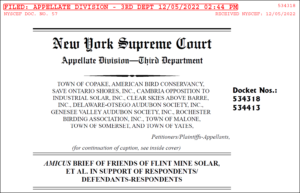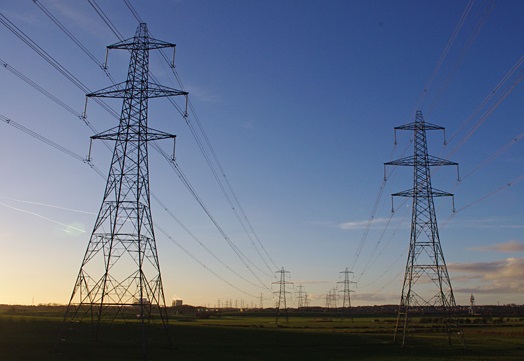 On December 2, 2022, the Renewable Energy Legal Defense Initiative (RELDI), in collaboration with the law firm Sidley Austin LLP, filed an amicus brief on behalf of five New York farmers and three community groups urging a New York appellate court to uphold the State’s new regulations for siting renewable energy projects. In our brief, we argue that the New York State Office of Renewable Energy Siting (ORES) did not violate the State Environmental Quality Review Act (SEQRA) when it promulgated regulations to implement the new siting process, because, among other reasons, ORES took a “hard look” at the potential impacts of the new regulations. The case is proceeding in the Appellate Division, Third Department, of the New York State Supreme Court under the caption Town of Copake et al. v. New York State Office of Renewable Energy Siting et al., Docket Nos. 534318, 534413.
On December 2, 2022, the Renewable Energy Legal Defense Initiative (RELDI), in collaboration with the law firm Sidley Austin LLP, filed an amicus brief on behalf of five New York farmers and three community groups urging a New York appellate court to uphold the State’s new regulations for siting renewable energy projects. In our brief, we argue that the New York State Office of Renewable Energy Siting (ORES) did not violate the State Environmental Quality Review Act (SEQRA) when it promulgated regulations to implement the new siting process, because, among other reasons, ORES took a “hard look” at the potential impacts of the new regulations. The case is proceeding in the Appellate Division, Third Department, of the New York State Supreme Court under the caption Town of Copake et al. v. New York State Office of Renewable Energy Siting et al., Docket Nos. 534318, 534413.
As previously reported on this blog, in April 2020, the New York Legislature enacted a law that created a new state agency, ORES, to take responsibility for permitting “major renewable energy facilities,” which include: (a) renewable energy facilities of at least 25 megawatts (MW); (b) co-located energy storage systems; and (c) associated electric transmission systems less than 10 miles in length. Developers of renewable energy facilities of at least 20 MW but less than 25 MW may also submit applications to ORES. The new law allows ORES to set aside local laws on a case by case basis if the agency determines that the laws, as applied to a particular facility, are “unreasonably burdensome” in view of New York state’s climate goals, as set out in the Climate Leadership and Community Protection Act, and “the environmental benefits of the proposed renewable energy facility.” The law also imposes statutory deadlines on agency decision-makers: in most cases, ORES is required to make decisions on issuing permits for renewable energy facilities within one year of determining that an application is complete.
In March 2021, ORES promulgated regulations to implement the new siting process, which the Town of Copake challenged as violating SEQRA, the State Administrative Procedure Act, and the home rule provisions of Article IX of the State Constitution and as being ultra vires. RELDI filed an amicus brief focused on rebutting the Town of Copake’s SEQRA claims on September 3, 2021. The trial court ruled in favor of ORES in two decisions issued on September 21, 2021 and October 7, 2021. The Town of Copake then appealed to the Appellate Division, Third Department, where the litigation is now pending.
In their opening brief on appeal, the Town of Copake argues that ORES violated SEQRA in several ways, including by: (1) not classifying the promulgation of new siting regulations as a Type I action within the meaning of the SEQRA regulations (i.e., one that presumptively requires the preparation of an environmental impact statement); (2) improperly deferring environmental impact review by issuing a negative declaration without considering the consequences of approving future projects under the new siting regulations; and (3) failing to take a hard look at the environmental impacts of the new siting regulations, including by rejecting concerns from commenters without sufficient reasoning or justification.
In our brief, we argue first that Type I actions are limited to certain actions “directly undertaken, funded or approved by an agency” and that the Town of Copake has not identified any relevant action directly undertaken, funded, or approved by ORES. We argue second that the Town of Copake has not established that ORES improperly deferred or segmented environmental review by declining to speculate about the impacts of future projects that may be approved pursuant to the ORES regulations but for which no specific plans yet exist. We argue third that the Town of Copake has not established that ORES failed to take a hard look: while ORES was required to consider and respond to comments, which the agency did at length, it was not required to agree with or adopt any particular comments.
The outcome of the case could have important implications for the build-out of renewables in New York. Since the new siting law was enacted in 2020, the pace of siting renewable energy projects has increased. From 2011 to April 2020, when the Legislature created ORES, only six renewable energy projects had made it through the old siting process, with some projects taking up to four-and-a-half years to receive approvals pursuant to Article 10 of the Public Service Law. Since March 2021, when the new siting regulations took effect, ORES has approved eight projects.
Matthew Eisenson is a Senior Fellow at the Sabin Center for Climate Change Law, where he leads the Renewable Energy Legal Defense Initiative (RELDI).






